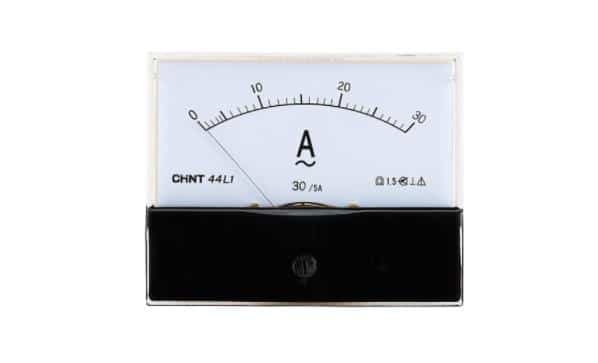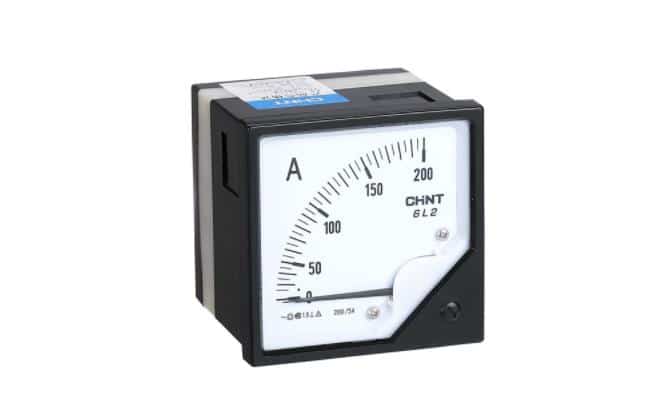Table of Contents |
Using analog panel meters, temperature, pressure, speed, flow, current, and voltage can all be measured. Usually, having a moving pointer or needle shows numbers on a dial for the user’s preference. A wide range of analog panel meters is available. A thermocouple or a resistive temperature sensor is the most common type that accepts a single input (RTD).
It is also common to use analog panel meters to measure pulses, frequencies, and other types of signals. There are multi-channel gadgets out there. Despite the advent of digital technology, analog panel meters are still needed in some situations.
Users who must scan a large number of devices to verify meter accuracy can benefit from analog panel meters. Anti-reflective, mirrored, and backlit analog panel meters are several options.
How does an analog meter work?
Analog panel meters necessitate a grasp of how they work before being selected. Taut band and pivot and gemstone are two of the most used ways. When used with a moving pointer or needle, tight bands reduce the amount of friction and improve meters’ sensitivities. In high-vibration situations, taut band devices can resist a wide range of shocks.
However, the accuracy and repeatability of pivot and jewel analog panel meters cannot be matched by taut band devices. Two jewel bearings hold the pointer and coil in place on the panel meter’s polished steel pivot.
Alternating current is typically measured using pivot and jewel devices (AC). As an alternative, devices with taut bands are frequently employed to gauge direct current flow (DC).
Analog panel meters can measure multiple variables in different units and have one or more channels. Some devices only use DC volts, while others only use AC voltage when it comes to the voltage measurement.
It is possible to measure single or three-phase power with analog panel meters. There are various RF signal measurement devices on the market. Panel meters typically have a measurement range of 0 to 10 VDC or 0 to 4 mA.
Where are analog meters used?
Alternating current is typically measured using Pivot & Jewel type meters, while direct current is generally measured with Taut band type meters.
It is also possible to measure numerous variables in various units using analog panel meters that include more than the one-meter channel. To measure three-phase power, they are often employed. A variety of devices can also measure Radiofrequency transmissions.
Analog Meter vs. Digital Meter
In measuring electrical current, voltage, and resistance, both digital and analog multimeters are excellent tools. But which of these instruments is better and better suited to long-term use? So what’s the Difference?
The first is digital, and it uses a digital screen to show numbers. An analog multimeter employs a needle scale to indicate how readings change over time, unlike digital multimeters.
Digital Popularity
The multimeter has evolved with technology. The digital multimeter has evolved from a simple needle scale device to display test results correctly on an LCD. That way, instead of a fluctuating impact on a scale, electricians may see the exact result they require.
Because digital multimeters are significantly more reliable than analog multimeters, demand for digital multimeters has climbed while demand for analog multimeters has decreased.
However, digital multimeters are considerably more expensive than analog. Analog multimeters can still offer a good test reading and often retail for much cheaper than digital multimeters.
Electricity Fluctuations
Electricity changes. The current might fluctuate at any time; therefore, the initial reading of a digital multimeter may not be reliable.
On the other hand, an analog multimeter can correctly indicate abrupt variations in the electrical flow. The analog multimeter won’t give you an exact reading like a digital multimeter, but it will give you a rough idea of unexpected oscillations and potential electrical faults.
Multimeter Scale
In this scenario, digital multimeters are the clear winners. When using an analog multimeter, it is the user’s obligation to guarantee that their readings are accurate. Incorrect use of the scale can lead to erroneous results.
On the other hand, a digital multimeter sets the scale for you and displays the hierarchy on the built-in screen.
Digital Special Features
Said, an analog multimeter does what it’s supposed to do: measure voltage and resistance. That’s OK if that’s all you want to use it. Digital multimeters can, however, be used for a wide range of jobs that go outside of their capabilities to measure current, voltage, and resistance, so you should be aware.
Examples include the ability to measure temperature with type-K thermocouples, power levels, data hold, auto/manual ranging, and a slew of other features. Others include true RMS, data have, auto/manual ranging, and more.
Types of Analog Instruments
Analog instruments (and digital instruments, for that matter) can be broadly categorized based on the quantity they measure.
Ammeters and Voltmeters are two different instruments that measure current and voltage, respectively. As a result, we have wattmeters, power factor meters, frequency meters, and other devices.
The type of current that an electrical instrument can monitor can also classify the devices. Tools that use electricity can be categorized as:
- Alternating Current (AC)
- Direct Current (DC)
- Direct and Alternating Current (DC/AC)
Instruments are classified based on which of the many effects caused by current and voltage are used for their working and can be categorized.
Analog instruments are also subdivided into the following:
- Integrating instruments
- Recording instruments
- Indicating instruments
CHINT analog panel meter
There are many different types of input signals available for pointer analog meter; thus, the interface can show virtually any unit of measurement. If you’re looking for a meter that can display a variety of metrics, an analog meter is your best bet.
The analog voltage or current, either AC or DC, are the input signals. 0 to 10 volts DC, four to 20 milliamps DC, or 0 to 100 volts DC are examples of DC voltage ranges. Except for the digital scaling of the display relative to the input signal, analog meters are essentially identical.
Here, we’ll discuss CHINT’s preferred analog meters.
NP Series Analog Panel Meter
It is an electromagnetic meter, the CHINT NP model. Measurement mechanisms and indicators are found in the meter, with a fireproof ABS engineering plastic casing, a printed dial, and a transparent glass top. The device is generally well-designed and offers a clear perspective to the user.
42,6 Series Analog Panel Meter
Using an inner magnetic structure, the 42,6 series panel meters have a measuring circuit, measurement mechanism, an indication device with a transparent glass cover, and a bakelite case with a printed dial.
44,59 Series Analog Panel Meter
The 44 and 59 series instruments use a magneto-electric type inner magnetic mechanism with a plastic cover, crystal glass windows, and a printed dial plate to achieve a more aesthetically pleasing, generous, and expansive appearance.
Conclusion
Analog Panel Meters measure and display analog signals directly, without a conversion process. The data values are displayed with a scale, pointer, and needle on the dial. It is possible to use an analog panel meter to show both a single signal and many signals, such as pulsed frequencies – several channels of analog panel metering.
Digital panel meters have mostly superseded analog products, while analog meters are still used in a few niche markets. An anti-glare and lit face are standard features on current analog meters.
For DC and alternating current (AC) circuits, the CHINT Pointer analog meter measures several power and frequency characteristics, including current, voltage, power, and power factor.
Industrial and mining, new energy, petrochemical and transportation, and shipping are among the industries where it is most commonly utilized in electrical equipment. The domain of power transmission and distribution. The design is simple and easy to assemble, the printing is clear, and the broad perspective.















